|
Here is a short
story about French flying ace Pierre Clostermann who, after his country capitulated
to the German Wehrmacht, went to England to fly for the Royal Air Force (RAF). It
appeared in the March 1962 issue of American Modeler magazine. His service
for the French resistance was spent downing German Focke-Wulfs, Junkers, and Messerschmitts
- 23 confirmed kills, 5 "probables," and 30 aircraft damaged. His fabled aircraft
was a Hawker Tempest, sister craft to the beautiful Hawker Hurricane. This control
line model is designed for a .60 size engine. The article does provide detailed
plans, but no description of the building or flying process. A separate full construction article for the
Hawker Tempest was
also published in this issue.
"Clo-Clo" Terror in a Tempest
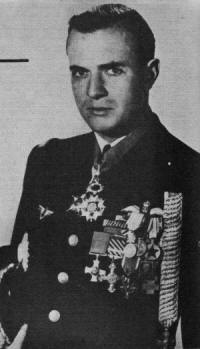
Pierre Clostermann
By
Walter A. MuscianoOn June 16, 1940 the Allied world mourned the collapse of the French Armed Forces
overrun by the German Wehrmacht and demoralized by the Nazi Luftwaffe. An armistice
between Germany and France soon followed. Many Frenchmen would not accept defeat;
they rallied to the side of General Charles De Gaulle who had formed the French
National Committee on June 18 to continue the fight.
Many brave and determined "Free Frenchmen" departed for Russia and England. These
warriors were welcomed in both countries where they joined one of the Allied armed
forces or formed Free French units of their own. One was Pierre Clostermann.
Clostermann, born in Brazil of French parents in 1921, later moved to France.
When his country capitulated he made his way to England; his father, Captain Jacques
Clostermann, was assigned to a post at French Headquarters in Brazzavile. Pierre
joined the Armee de l'Aire at the age of twenty; wearing the distinctive dark blue
French uniform, he trained at the Royal Air Force college at Cranwell. By 1942 the
Frenchman had soloed in a "Spitfire" at Rednal Operational Training Center. In 1943
he was assigned to the "Alsace" No. 341 Squadron, R.A.F. as part of the Biggin Hill
Wing. Commandant Mouchotte was the squadron's leader; Lieutenant Martell led the
flight to which Sergeant Clostermann was assigned. Famous British Ace A. B. "Sailor"
Malan was the Group Captain.
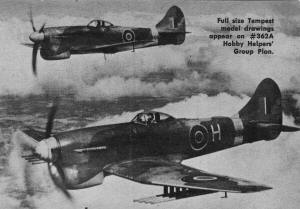
Hawker Tempests in formation flight.

Pierre Clostermann in his Hawker Tempest - lots of confirmed
kills.
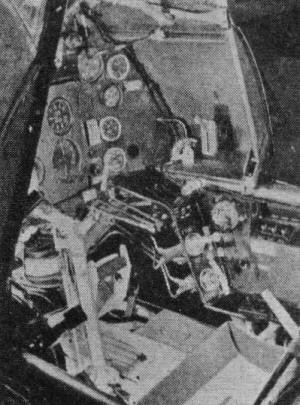
Hawker Tempest cockpit.
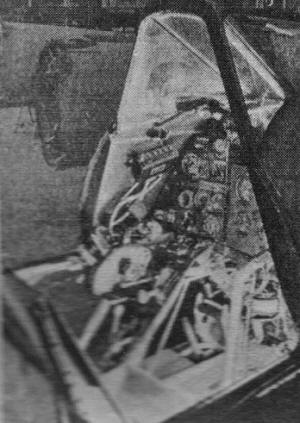
Hawker Tempest instrument panel.
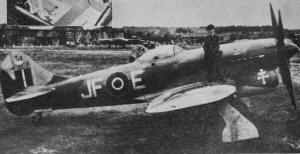
French Ace Clostermann and his Tempest.
On July 26, 1943 Pierre scored his first victory by shooting down two Focke-Wulf
190 fighters from the crack German unit, Jg-2. After destroying his fourth enemy
fighter on 9/26/43 Clostermann was transferred to No. 602 "City of Glasgow" squadron
composed of Australians, New Zealanders, Scotsmen, Canadians, Frenchmen, Englishmen
and Belgians ... a true pot-pourie of nationalities. "Clo-Clo" (Pierre) became an
Ace over Germany during the famous Schweinfurt ball bearing factory raid when Spitfires
from "602" tried in vain to protect the attacking B-17's.
During Spring 1944 this R.A.F. squadron was kept busy dive bombing V-1 launching
sites in their Spitfire IX aircraft. Since the fighters had to fly through a deadly
wall of defending flak Spitfire losses were high. When the Normandy invasion was
in full swing Clostermann and one of his buddies decided to attack German airfields
on a freelance sortie. The pair took off with their squadron mates but soon slipped
away unseen. They chanced upon a camouflaged enemy airfield and swooped down to
strafe a number of planes on the runway. One Messerschmitt 109 tried to take off
but Clostermann shot him down on the field's main runway. Upon their return to 602's
airfield at Ford, near Brighton, England, the two were severely admonished. This
breach of discipline was pretty much forgiven when intelligence learned the culprits
had discovered the secret field!
On June 17, 1944 No. 602 Squadron was transferred to an airfield on the Continent
near Longues, France. About this time Clostermann was promoted to flight leader.
During one aerial battle Pierre shot down three Focke-Wulf TA-152 "long noses" and
damaged two others. The intrepid Free French fighter was presented with the Distinguished
Flying Cross by Sir Archibald Sinclair, the British Minister for Air. Pierre was
sent to England for rest after flying more than 300 sorties!
During January 1945 Lieutenant Clostermann was assigned to No. 274 Squadron,
R.A.F., as leader of "A" Flight and temporary commander of the squadron. No. 274,
stationed in Volkel, Holland, . was equipped with new Hawker "Tempest" fighters.
These speedy machines enabled the squadron to attack the Messerschmitt 262 twin
jet fighters which were appearing over the Western Front in ever increasing numbers.
Clostermann and the other Tempest pilots found that the only way to successfully
shoot down a 262 was to head for the jet's base as soon as word was received regarding
a jet plane sighting. As the Messerschmitts approached their base and extended their
landing gear, lowered their flaps, and throttled back the Tempests dived upon the
then almost helpless jets and destroyed them. This particular Hawker was one of
the few Allied planes that could successfully attack a 262.
During early 1945 "Clo-Clo" and the 274th shot up trains and trucks, more jets
and more long-nose Focke-Wulf fighters. This was dangerous work and the squadron
lost thirty one pilots during one month.
After escorting a paratrooper attack, shooting up a supply train, strafing a
panzer column, pulverizing troop-carrying trucks, then attacking a railroad yard
- all in one day - Clostermann was ordered to organize a flight at six-thirty in
the evening of 3/24/45. This was to maintain patrol near an enemy jet fighter base
to determine if the Germans were evacuating their 262 jets to the interior. When
the young Lieutenant took off with three comrades it was a black night with exceptionally
poor visibility. Suddenly Pierre spotted the exhaust of a German Junkers 88 night
fighter to his left. He swung to the attack and fired almost blindly. To his surprise
the German plane erupted in a sheet of flame. The Tempest's four cannon had scored
a direct hit! An instant later another Hawker streaked by and struck the flaming
Junkers.
Clostermann realized that his wingman had smashed into the German at top speed
before he could swerve. The Ace was so stunned he forgot he was heading directly
over the anti-aircraft defenses of the German jet field! Without warning two direct
hits struck the lone Tempest. The stunned pilot felt a burning sensation in his
right leg. He was on the verge of losing consciousness when a cold draft, whistling
through jagged holes in the fuselage, brought him wide awake. A quick check showed
all important instruments inoperative; his radio was smashed, no recognition lights
could be turned on. The cockpit canopy runner was bent, the hood would not open
nor would it jettison! This eliminated any possibility of bailing out ... injured
leg or not! Following the Rhine River to Arnheim, then the Meuse, finally a familiar
railroad track, Clostermann located his base. He brought his damaged Tempest in
for a belly landing. As the craft struck the ground the shoulder harness snapped
and the Frenchman was thrown against the reflector gun sight. Rescue teams plucked
the semi-conscious Ace from the cockpit before fire consumed the wreck.
Eight days after his forced landing Lieutenant Clostermann was out of the hospital
and assigned to No. 3 Squadron as commander of "A" Flight.
During the war Clostermann completed 420 combat missions. He shot down thirty-three
Germans including aircraft such as the FW-190, Me-109, Ju-88, He-111, Do-24, Ju-252,
and Ju-290. In addition there were 12 more "probables" plus 24 aircraft destroyed
on the ground during strafing missions. The Royal Air Force officially credits "Clo-Clo"
with 23 victories, 5 probables, and 30 damaged aircraft due to their rather meticulous
method of figuring victories.
After the war the Ace entered French politics and became Parliamentary Deputy
for Strasbourg.
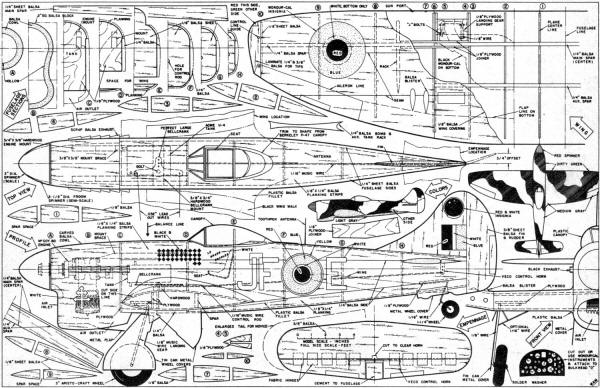
Hawker Hurricane Plans
Notice:
The AMA Plans Service offers a
full-size version of many of the plans show here at a very reasonable cost. They
will scale the plans any size for you. It is always best to buy printed plans because
my scanner versions often have distortions that can cause parts to fit poorly. Purchasing
plans also help to support the operation of the
Academy of Model Aeronautics - the #1
advocate for model aviation throughout the world. If the AMA no longer has this
plan on file, I will be glad to send you my higher resolution version.
Try my Scale Calculator for
Model Airplane Plans.
Posted February 20, 2022
(updated from original post on 10/6/2013)
|



